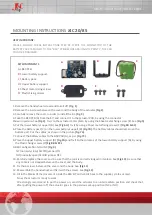
Palette Entry 1
Palette Entry 0
Palette Entry 3
Palette Entry 2
Palette Entry 5
Palette Entry 4
Palette Entry 7
Palette Entry 6
Palette Entry 9
Palette Entry 8
Palette Entry 11
Palette Entry 10
Palette Entry 13
Palette Entry 12
Palette Entry 15
Palette Entry 14
3
0
3
0
7
4
7
4
11
8
11
8
14
12
14
12
15
15
Blue
Green
Red
Blue
Green
Red
000
Type
0
0
31
16
15
0
Picture Data
8 Words
First Entry
Subsequent Entries
Functional Description
1386
SLAU723A – October 2017 – Revised October 2018
Copyright © 2017–2018, Texas Instruments Incorporated
LCD Controller
20.3.6 Palette RAM
The palette RAM is a programmable cross reference table that maps a small set of input codes into a
larger set of output codes. For active matrix displays, the palette RAM programmed in the LCD is used
only for color source images. For passive matrix displays, the palette RAM is used for both grayscale and
color source images. For color components, the passive matrix mode only supports, 4 bits per color
component. One, two, three, and eight bit per pixel (bpp) source images always use the palette. Twelve,
16, and 24 bits per pixel do not use the palette RAM, since raw data transfers occur.
The LCD palette RAM uses a 12-bit output code such that there is a possibility of 4096 color options to
choose from. Depending on the bpp frame storage of palette RAM, two, four, 16, or 256 palette colors can
be stored in the palette RAM.
20.3.6.1 Palette RAM Structure for 1, 2, and 4 Bits Per Pixel
When palette RAM is enabled for 1-, 2-, and 4-bpp frame storage, the palette buffer is 16 word entries,
where the upper half of the word is unused. The first entry of the palette RAM contains the encoding for
the palette type (1, 2, 3, 6, or 12, 16, 24) of the stored picture on bits [14:12], as well as the first input
code for one palette entry (bits [11:0]). Subsequent entries only contain the input codes for next palette
entries.
shows the frame buffer structure.
Figure 20-4. Palette RAM Structure for 1, 2, and 4 Bits Per Pixel
For 1-bpp source pictures, the first two palette entries are valid; for 2-bpp sources, the first four palette
entry sources are valid; for 4-bpp, all 16 palette entries are valid. Even if the palette entries are not valid
for a particular type, there is a fixed number of 8 words reserved for the palette RAM.















































